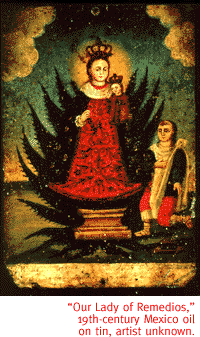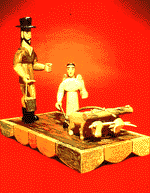

|

'El Alma Del Pueblo' At TMA Captures The Lives Of Old- And New-World Artisans.
By Margaret Regan
OUR LADY OF the Rose has no relation to the over-exposed
Rose of the movie Titanic, but she's a queen of the sea
all the same. Lashed to a wall at the Tucson Museum of Art, she's
a gorgeous carved ship's figurehead who bears a wooden rose in
her hand. Once upon a time, she guided Spanish sailors across
the Atlantic's treacherous seas. Right now she helps visitors
navigate their way through the gigantic show El Alma del Pueblo:
Spanish Folk Art and Its Transformation in the Americas.
 Produced by a folk artisan in the port city of Barcelona around
1900, "Our Lady of the Rose" is just one of the many
pleasures in this wholly pleasurable show, which opened last week
in TMA's newly expanded galleries. The exhibition unapologetically
presents the work of "el pueblo," of the shepherd, the
sailor, the blacksmith, as worthy of museum display. For southern
Arizonans who've grown a tad weary of shows of our own region's
multicultural folk traditions, El Alma offers a refreshing
visual change. There are religious paintings and trinkets, embroidered
christening caps and carved furniture, walking sticks and puppets,
festival figures and pottery, popular graphics and ironwork, making
for an altogether lively mix of functional and ceremonial crafts.
Fully two-thirds of its 308 objects are from Spain; one-third
are from the New World, but they hail as much from Puerto Rico,
Peru, Colombia and Bolivia as from Mexico.
Produced by a folk artisan in the port city of Barcelona around
1900, "Our Lady of the Rose" is just one of the many
pleasures in this wholly pleasurable show, which opened last week
in TMA's newly expanded galleries. The exhibition unapologetically
presents the work of "el pueblo," of the shepherd, the
sailor, the blacksmith, as worthy of museum display. For southern
Arizonans who've grown a tad weary of shows of our own region's
multicultural folk traditions, El Alma offers a refreshing
visual change. There are religious paintings and trinkets, embroidered
christening caps and carved furniture, walking sticks and puppets,
festival figures and pottery, popular graphics and ironwork, making
for an altogether lively mix of functional and ceremonial crafts.
Fully two-thirds of its 308 objects are from Spain; one-third
are from the New World, but they hail as much from Puerto Rico,
Peru, Colombia and Bolivia as from Mexico.
Like that lovely figurehead, many of the Old World works remind
us that Spain was once a great seafaring nation. (In fact, when
the traveling show visited Miami, curators imposed a maritime
theme on it, building display cases that suggested ships.) Some
of the exhibition's most charming works were created by sailors
relieved to have weathered a dangerous crossing. The three-dimensionally
inclined made detailed models of sailing ships; those who favored
a flat surface painted colorful "ex-votos" depicting
near-wrecks at sea, with the intervening saint or Virgin Mary
supervising from one corner. The grateful sailing craftsmen would
hang their models or paintings in churches in thanksgiving for
their safe passage. A splendid example of a ship model from Cataluña,
complete with a mosaic of shells beneath, is from the 19th century;
and so are most of the little shipwreck paintings.
Even the arte pastoril, the art made by the shepherds
left behind by their seafaring brothers on Spain's craggy hillsides,
somehow speaks of the sea. The Spanish shepherds had a carving
tradition akin to the scrimshaw of whaling New Englanders. They
made intricate incisions on the bones of their dead sheep, or
on the horns of their goats, delicately creating scenes of a bullfight
(in a 19th-century Salamanca cup) or even, in one case, perhaps
awed by a sailor's fantastic tales, lovingly carving the mythical
creatures of the deep.
 The erudite show, replete with informative wall texts and a scholarly
catalog, was curated by Marion Oettinger Jr. of the San Antonio
Museum of Art. Bringing an anthropological bent to his aesthetics,
Oettinger traces the evolution of some genre objects as far back
as the Greeks and Romans. A tiny Greek horse, a bronze from about
500 B.C., was found in Andalucia. It's an ex-voto ancestor of
the milagro, the silver legs and hearts so plentiful today
in South Tucson and parts farther south. He tells us that Roman
ex-votos too have been found in Spain. Made of wood, wax, bones
and metal, they were "testimonials to the power of the spirit
world."
The erudite show, replete with informative wall texts and a scholarly
catalog, was curated by Marion Oettinger Jr. of the San Antonio
Museum of Art. Bringing an anthropological bent to his aesthetics,
Oettinger traces the evolution of some genre objects as far back
as the Greeks and Romans. A tiny Greek horse, a bronze from about
500 B.C., was found in Andalucia. It's an ex-voto ancestor of
the milagro, the silver legs and hearts so plentiful today
in South Tucson and parts farther south. He tells us that Roman
ex-votos too have been found in Spain. Made of wood, wax, bones
and metal, they were "testimonials to the power of the spirit
world."
The spirit world of Spanish Catholicism quite rightly gets ample
play in this show. There's a beautiful "Virgin and Child"
carved in the severe Gothic style of the 14th century. A later
artisan, steeped in the Spanish baroque, added gilt and paint
to dress them up. An ex-voto painting is dedicated to San Ramón
Nonato, patron saint of midwives and women who give birth by Caesarean
section (curiously he's a Dominican monk). The relieved mother
smiles in bed, the midwife cradles the infant and the dad does
his part by praying on his knees to the saint, who hovers up in
the left-hand corner. Religious art tells us about the people's
alma, or soul, as the exhibition title reminds us, but
as the childbirth picture demonstrates, it also conveys information
about the soul of secular life. Similarly, an ex-voto of stone
masons tumbling from a wall reveals their clothing, tools and
building techniques. The painting sailors, of course, enlighten
us about the tricks of their trade.
The secular objects show how that same spirit of the people can
make the ordinary more fun. A ceramic lizard is a toothpick holder;
a carved writhing snake is walking stick; a sculpted face looks
out from the drawer of a chest. A fine ironwork section proves
that folk art and fine art don't always work in isolation, either.
A fabulous iron sign from a 1900s Barcelona butcher shop is adorned
by the amiable heads of those the butcher would kill: a cow, a
sheep, a pig. But this extravagant affair, highlighted by punched-out
letters, owes a debt to the high-arts modernism that swept Barcelona
in those days. The fertile dynamic of turn-of-the-century Barcelona
helped give rise not only to the anonymous imaginative ironworker
and the carver of "Our Lady of the Rose" but also to
"high" artists like Picasso and the innovative Barcelona
architect Gaudi.
 Many of the folk objects are reprised in slightly altered form
in the Americas section of the show. We find carved horns, glazes
ceramics, Mexican retablo paintings, echoes of the Spanish ex-votos;
innumerable Blessed Virgins (the Spanish Lady of Guadalupe's transformation
into Mexico's patron saint is discussed). A high-relief "Our
Lady of Montserrat" from 1820s Puerto Rico has black skin
and she's seated under a grove of Caribbean ceiba trees. In a
19th-century "Adoration of the Magi" painting from Peru,
the familiar stable is set in the snow-capped Andes and the shepherd's
wearing a poncho.
Many of the folk objects are reprised in slightly altered form
in the Americas section of the show. We find carved horns, glazes
ceramics, Mexican retablo paintings, echoes of the Spanish ex-votos;
innumerable Blessed Virgins (the Spanish Lady of Guadalupe's transformation
into Mexico's patron saint is discussed). A high-relief "Our
Lady of Montserrat" from 1820s Puerto Rico has black skin
and she's seated under a grove of Caribbean ceiba trees. In a
19th-century "Adoration of the Magi" painting from Peru,
the familiar stable is set in the snow-capped Andes and the shepherd's
wearing a poncho.
Not all uses of folk art are benign of course. San Isidro Labrador
was a 12th-century Spanish farmer who became the patron saint
of farmers all over Latin America. In an 1866 Bolivian painting,
though, he is not a benevolent protector so much as he is an arrogant
ruler. A huge figure presiding over a Bolivian hacienda, the giant
San Isidro dwarfs an entire population of workers. The painting
gives us much information about the life of the people, from their
assorted ethnicities to their trades. But this painting, no doubt
commissioned by the hacendero himself, works to justify
the man's rule: He's made himself the equivalent of a saint. A
beloved folk symbol venerated by the people has been usurped by
their master. 
El Alma del Pueblo continues through August 2 at
the Tucson Museum of Art, 140 N. Main Ave. Gallery hours are 10
a.m. to 4 p.m. Monday through Saturday, noon to 4 p.m. Sundays.
Admission is $2. Free family passes are to be distributed to most
public school students in Tucson. The museum has scheduled assorted
events related to the show, including free Wednesday lectures
at noon through June 10. Jane Haller will speak about Tucson murals
at noon on Wednesday, May 6. For more information, call 624-2333.
|
 |





